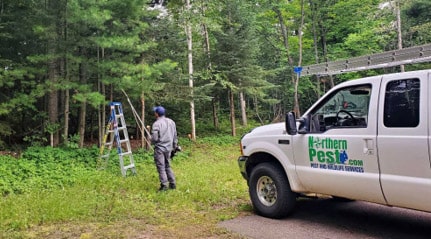Bald-Faced Hornets

Bald-faced hornets are most problematic in the late summer when their colonies are largest. Classified as “social insects,” bald-faced hornets work together to build their papery grey hive containing 100 to 400 members. Bald-faced hornets are larger than wasps and are primarily black with a white face. Unlike other stinging insects, Bald-faced hornets are more hostile and will go after anything/anyone who invades their space. They have smooth stingers, which allow them to sting repetitively, whereas honeybees can only sting once before their stinger falls off.
You can recognize an active bald-faced hornet nest as a grey, paper-like encloser, suspended from the ground, and are as large as 14 inches in diameter and can be more than 24 inches in length. The nest hangs at least three feet in the air, either within a tree or attached to overhangs, etc., and worker bald-faced hornets will be flying nearby.
Avoid bald-faced hornets and their nests! If you happen to stumble upon their presence, calmly remove yourself from the area and call a licensed pest control company, like Northern Pest, for safe removal. Do not attempt to remove the nest on your own, as this will likely aggravate the colony and cause them to sting.

While being stung isn’t usually dangerous, 30 or 40 stings can kill a person. Read on the learn more:
Tips to Prevent Getting Stung:
- Cover up; wearing long sleeves and pants is the best way to reduce the risk of stings
- Regular check your property and seal up any tiny openings and cracks to prevent pest harborage
- Keep picnic food and drinks covered
- Avoid wearing strong fragrances; opt for unscented hygienic products
- Avoid wearing bright colored clothing like yellow, purple, blue, and red
- Wear closed-toed shoes to protect your feet from rogue hornets
- Leave the hive alone; call Northern Pest!
How to Behave Near Stinging Insects:
- Don’t flap! A human’s natural reaction is to swoosh an insect away, but this angers hornets more.
- If a couple of pesky hornets are investigating you, try to hide in plain sight, keep still, and hold your breath for 10 seconds, 30 seconds, or longer, so they no longer detect your presence.
- Walk swiftly but calmly away in the opposite direction; don’t give stinging insects more reason to feel threatened.
- If a swarm attacks you, run as fast as you can away from it, in a straight line, and head indoors. Close the shelter door behind you to limit those who followed and turn the lights on to disorientate those that crept inside.
- Leave the hive alone; call Northern Pest!
What to Do If Your Stung:
- Move away, and seek a safe, sting-free zone.
- If a stinger is found, remove it using tweezers or your fingernails.
- Wash the area(s) with soap and water to avoid infection. Use a topical steroid or an oral antihistamine to reduce swelling and pain. You can also elevate the area and apply cold compresses to help.
- If you have a history of severe allergic reactions, remember always to carry your auto-injectable epinephrine.
- If you are stung in the mouth or near your eyes, call your doctor or 911.
- If the sting sites do not improve within a couple of days, call your doctor or 911.
Call 911:
- If you experience abnormal swelling, especially of the face, mouth, or throat
- If you are wheezing or have shortness of breath
- If you are nauseous or vomiting
- Have a fast heart rate
- Feel dizzy or faint
- Have difficulty swallowing
- Lose consciousness